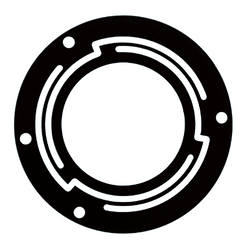Grafoil
Grafoil® is compactable, resilient, and conformable, or compliant. It’s chemically resistant to fluids, can withstand a lot of heat and pressure, and fits snugly to any surface to prevent leaks.
Grafoil’s unique physical and chemical properties make it ideal for sealing and for high-temperature applications. The flexibility of Grafoil is due to its naturally-occurring graphite flake. The crystal structure of natural graphite consists of layered planes of carbon atoms with bonding between the planes. This structure leads to the electrical, thermal, and mechanical differences in the conventional properties of graphite and explains its natural lubricity.

Manufacturing
Grafoil’s flexible composition is produced by chemically treating natural graphite flake to bond the layers and then heating them to decomposition. The result is an over eighty-fold expansion in size that produces a vermiform structure with highly active, dendritic, rough surfaces that are usually calendered into sheet form.
Application
Grafoil’s sheets can be laminated together to form gaskets for many uses. The laminate can be thermally treated to decrease outgassing when used in a high-temperature application. The sheets can also be laminated with metallic and nonmetallic materials to improve handling, blowout resistance, and mechanical strength.
Grafoil is an ideal replacement for asbestos-based gaskets, with most organic and inorganic chemicals that are non-oxidizing, and also is superior to conventional elastomeric bonded gasketing. Laser routing allows for gaskets to be mechanically machined out of the non-melting, soft material of Grafoil.
A-Laser Grafoil
A-Laser wants to produce custom gaskets for you with our UV lasers and expert handling. Simply create the design and leave the rest to our capable machines and team.
Once you use Grafoil, you’ll wonder how you ever produced in today’s market without it!

*Click image to enlarge
History of Grafoil
The 20th century brought amazing advances in science, medicine, and technology. Cars, planes, and computers are just some of the inventions that have enabled us to accomplish more in less time and to explore new horizons.
Most of the discoveries made go unnoticed, however, while the biggest inventions take the headlines. A plethora of those discoveries can be categorized under the umbrella of polymers.
Polymers are revolutionary materials that took mankind from an era in which everything was made out of metal, wood, or glass to a whole new reality. This allowed for advanced technology that is lighter, stronger, and virtually indestructible.
Perhaps the most extraordinary characteristic of polymers is that, while they may look unnatural or inanimate, they are in fact made from the same building blocks that constitute all living organisms – carbon.
While scientists were marveling upon their discovery of graphite’s capabilities, they instinctively continued to push the envelope to improve upon their polymer development. Graphite’s thermal stability, conductivity, lubricious nature, and chemical resistance were simply not enough.
Graphite was very brittle and non-compactable. While that’s ideal for use in pencils, the need for flexible graphite was the driving force for more experimentation and design. From this need, the innovative product known as Grafoil was born.
